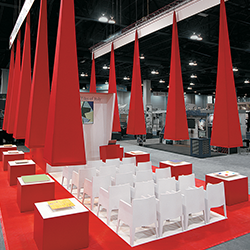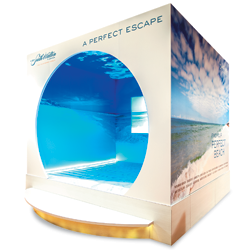|
lighting
 illustrations: Bill Butcher
Strategic Lighting: How to Outshine the Competition
According to famed New York designer and architect Benjamin Noriega-Ortiz, "Lighting is the magical ingredient that makes or breaks a space." And for exhibitors, lighting can literally be the difference between attendees finding, entering, and spending time in your stand or completely passing it by virtually unnoticed. That said, many exhibitors are still in the dark about lighting's many uses. While they may understand its importance, they're not quite sure how to implement it or best apply its benefits. Thus, EXHIBITOR spoke with two lighting experts – Tom Farin, founder and owner of Pegasus Lighting, and Roman Moszkowicz, national sales manager at Prism Lighting Group – to compile this down-and-dirty primer. Their advice outlines four common ways that lighting can benefit exhibitors and provides tips to help transform dark, invisible voids into alluring attractions.
By Linda Armstrong
Attracting Attention
Within a dim exhibit hall, pops of light draw the eye like a cool pool of fresh water in the Sahara. Lighting attracts, lures, and soothes, and amid a darkened space, it helps your booth stand out from the competition. However, if you step up your lighting game just a smidge, you can attract even more eyeballs by adding movement and drama to your environment. "The best way to attract attention is to create an obvious luminous contrast between what is being lit and what isn't," says Tom Farin, founder and owner of Pegasus Lighting. "By lighting your stand in a sea of darkness, your booth pops against those around it. But if you light everything in your booth equally, you mute the potential impact." So by all means, use lighting to lure the eye, but rather than blast the entire space with the same level of illumination, choose focused points to capture attention. Tactics: 1 Simply adding arm lights to a 10-by-10 or incorporating LED tape lights to frame your back-wall graphics may be all you need to illuminate your space and differentiate it from the competition. 2 To attract even more attention, Farin suggests adding floor-based "uplights" and overhead spotlights to accent key areas of the design. 3 If you really want to ratchet up the attention-grabbing factor, use illumination to add drama and ambiance to your space. Such options include everything from colored lighting and sequential patterns to choreographed light shows and rotating gobos. Accenting Products and Key Messages "Obviously you want your wares, key messages, and graphics to be seen," Farin says. "Conversely, you want to deemphasize other aspects of your space, such as your storage room, literature stand, garbage cans, etc." Lighting allows you to direct attention to these focal points and away from ancillary elements. "Think of accent lighting as picture framing," says Roman Moszkowicz, national sales manager at Prism Lighting Group. "In effect, lighting frames your 'artwork,' whether that's a product, a message, or simply a demonstration area. Lighting separates your art from the surrounding gallery." Just like you wouldn't slap the "Mona Lisa" on a wall without a suitable frame, you shouldn't drop your products and messages into a booth without proper framing. Tactics: 4 "LED fixtures can often fit into tight spaces where lighting could not be applied in the past," Moszkowicz says. "This means you can draw visitors' eyes to tiny products housed within your exhibitry, small graphics in key locales, or miniscule components." 5 According to Farin, myriad fixtures can be used to accent products and messages, including track lighting, arm lights, LED recessed puck lights, picture lights, rope lights, shelf lights, monopoint lights, niche lighting, microfluorescent lights, and more. 6 "Lighting in motion produces an almost involuntary reaction, causing viewers to instinctually follow a pattern of light that is moving or changing in front of them," Moszkowicz says.  Guiding Traffic
Guiding TrafficUnless you have an itty-bitty space, you probably have a preferred route you'd like attendees to take within it – even if that means simply stopping first at a reception desk and then moving to a product display. Just as illumination catches the eye, it can also direct movement, as people are physically drawn from one element to the next using lighting as the lure. Keep in mind that while certainly effective, lighting is just one of many tools available to aid wayfinding. "Directional wayfinding is a science in itself; just ask the myriad people that have ever been lost in a hospital or university," Moszkowicz says. "Thus, lighting isn't the do-all panacea to wayfinding, but it can draw attendees' eyes and thus their feet on a specific path through your space." Tactics: 7 Moving lights that cast a strong beam in a specific path can communicate a sense of direction and movement to the attendee, who is likely to follow that beam in the trajectory you intend. 8 More obvious wayfinding lighting techniques include LED tape lights embedded in the floor to craft a traffic pathway, Farin says. Illuminated floor tiles can also communicate where you'd like attendees to stand for activities. 9 One way to employ lighting as a directional tool is to bathe various portions of your space in a specific color of light, Farin suggests. While this may not draw people through your space in a logical fashion, the color changes can communicate different product groupings or activity zones, thereby allowing visitors to self-direct their experiences. Purporting Permanence and Establishing Mood Moviegoers often find their 90 minutes in a theater so inspiring that they become emotionally invested in the story. You want attendees to do the same, i.e., ignore the impermanence of your temporary structure and feel involved with the experience, which usually equates to increased trust and perception of value. Thankfully, lighting can help generate such a vibe. "A food truck doesn't deliver the same amount of permanence and trust as a brick-and-mortar restaurant," Farin says. "Exhibits are no different. The more you can establish a mystique of permanence, the more trust and loyalty you're going to develop in its visitors. So turn to layered lighting, shadows, and varied lighting experiences to develop that staying power." Tactics: 10 According to Farin, layered lighting designs using a mix of ambient, accent, and task lighting with various tones and temperatures create the sense that your temporary stand is as permanent as any home or retail store. 11 "When one thinks of permanence, the mind is drawn to architectural buildings, which feature shadows, color variations, and textures," Moszkowicz says. "Adding these elements to your stand via light can further the illusion of an immutable structure." 12 Before you implement any lighting design, Farin recommends that you first decide how you want attendees to feel within your space. Then communicate your desires to a lighting designer or determine for yourself how colors, temperatures, and movement can be used to foster those emotions.
|
|
|
||||||||||||||||||||||||||||
|
|
||||||||||||||||||||||||||||
|
TOPICS Measurement & Budgeting Planning & Execution Marketing & Promotion Events & Venues Personal & Career Exhibits & Experiences International Exhibiting Resources for Rookies Research & Resources |
MAGAZINE Subscribe Today! Renew Subscription Update Address Digital Downloads Newsletters Advertise |
FIND IT Exhibit & Display Producers Products & Services All Companies Get Listed |
EXHIBITORLIVE Sessions Certification Exhibit Hall Exhibit at the Show Registration |
ETRAK Sessions Certification F.A.Q. Registration |
EDUCATION WEEK Overview Sessions Hotel Registration |
CERTIFICATION The Program Steps to Certification Faculty and Staff Enroll in CTSM Submit Quiz Answers My CTSM |
AWARDS Sizzle Awards Exhibit Design Awards Portable/Modular Awards Corporate Event Awards Centers of Excellence |
NEWS Associations/Press Awards Company News International New Products People Shows & Events Venues & Destinations EXHIBITOR News |
||||||||||||||||||||
|
||||||||||||||||||||||||||||






